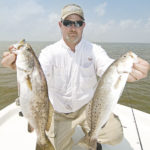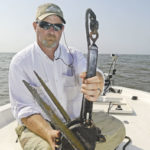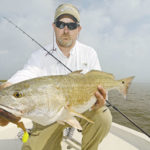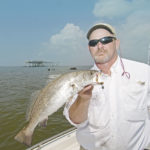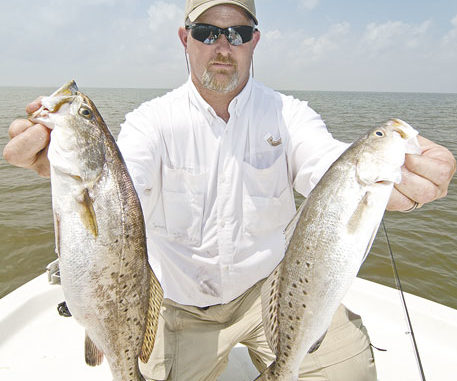
Black Bay’s many wellheads hold plenty of summertime speckled trout
Meteorology isn’t real science. It’s like alchemy, in which so-called scientists worked to turn base metals into gold. Alchemists never got around to actually producing any gold, and meteorologists rarely do more than guess at what will happen with the weather.
But it seemed the weathermen couldn’t go wrong in late April: just forecast high winds, and the odds were you’d be correct.
So it wasn’t a surprise when St. Gabriel angler Seth Smith and I planned our Black Bay trip to find the wind forecast for 10 knots and climbing throughout the day. And, honestly, neither of us wanted to be out there.
“I was sort of hoping a big storm would blow up and cancel the trip,” Smith said.
I chuckled and admitted that I had been dreading the trip for the same reason.
But when we met at Beshel’s Marina in Pointe a la Hache at daybreak, we were astounded. Barely a breeze was blowing.
It’s not that we were surprised the weathermen were wrong: That’s not unique. It’s just that they were SO wrong.
But we weren’t exactly complaining.
“I’ll take this kind of 10 knots every day,” Smith laughed.
We didn’t waste much time wondering about how the forecast could be so wrong. We just quickly loaded up and launched Smith’s boat, and headed south down the levee canal to the Twin Pipelines, where we cut east into the bay.
We were met by a slight ripple on water that was less than pretty. But Smith, who goes by “mule_chaser” on LouisianaSportsman.com, said it wasn’t too bad.
“I came out here Sunday, and couldn’t get out because of the wind,” he said. “The water looked like you could plow it.”
Smith is really a transplanted saltwater fisherman, originally a bass angler hailing from Mississippi. He was introduced to Black Bay only three years ago by a buddy, but instantly fell in love.
“Once I’d been out here once and caught solid 18- to 20-inch trout, it was kind of hard to stay in (the marsh),” Smith said.
He fishes pretty much every weekend during the spring and summer, and has learned that Black Bay is almost a guarantee.
“I’ve only blanked twice in Black Bay,” Smith said. “Both times have been in the early spring.”
Other than those two tough trips, Smith and his family have hauled lots and lots of meat home. That kind of success keeps him coming back time after time.
“I don’t like fishing; I like catching,” he laughed.
Smith believes the reason for the consistency is tied directly to the oil production in the area.
“There’s just so much structure out here,” Smith said. “There’s just so much debris out here in Black Bay.”
Indeed, the bay is dotted with rigs and wellheads. It can all be so confusing to anglers, but Smith said his approach is pretty basic.
“I’ll just jump around until I find fish,” he explained.
In fact, that’s exactly how he found some of the most-recognizable features in the bay. Places like Stone Island, the Eight Piles, the Iron Banks and The Wreck were all marked on his GPS as he hopped around the open waters of Black Bay — even before he had a clue they had names.
“A lot of (the spots) I had found but I didn’t know what they were called,” Smith laughed. “A lot of it was seeing coordinates posted on LouisianaSportsman.com, and I was right there.
“I was reading an article in Louisiana Sportsman about The Wreck, and said, ‘Oh, that’s what it’s called?’”
Stone Island, the Eight Piles and The Wreck sort of outline his regular run, but he doesn’t stick with just those community holes.
In fact, we were heading right for a spot — a decommissioned rig site just north of Stone Island — he’s never seen anyone else fish.
“The rig was removed,” Smith said. “I have always caught fish there, but I only know where it was because I had marked it on my GPS.”
This stop is a little out of his normal routine, since he is most comfortable working visible structure.
“I’m a bass fisherman; I like to fish structure,” Smith said. “I just have more luck when I do that.”
But he makes an exception to that rule here because he’s been so successful.
“I don’t know if there’s a shell pad down there or what. If there is, I can’t see it on my depth finder,” he said. “But for whatever reason, it usually holds fish.”
However, we didn’t get a nibble on this trip. After about 15 minutes, Smith pulled up his trolling motor and moved to Stone Island, but struck out there, as well, after moving all the way around the island.
Smith doesn’t waste a lot of time in any one spot; his goal is simply to fish an area thoroughly without killing his day.
“I’ll usually give it about 15 minutes before moving,” he explained. “If I’m fishing a shallow area and stir up the water coming in, I’ll give it 10 or 15 minutes to settle down and then give it another 15 minutes before moving.”
Water clarity could have been an issue on this day: The water was fairly dirty, although it looked fishable.
After circling the island and picking up only a big redfish that we photographed and released, we again made a move. This time, we pointed the bow toward the Iron Banks.
The water was much more fishable, although the actual rusty steel structure was obscured by fog to the point where we had trouble locating it. We began working a nearby island, and picked up a couple of fish.
As the fog dissipated, the Iron Banks came into view, and we saw two boats anchored off the rusting remains of the structure. We soon decided to join them.
The fish were there. We quickly picked up a few trout that were obvious keepers but far from monsters, but one of the boats had located the mother lode — and the three anglers were camped out, raking in fish cast after cast.
“They have to catch their limits pretty soon,” I told Smith.
The other boat finally left, and we began trolling back and forth around the standing structure. We picked up a fish here and there, but that boat anchored on that one spot was just killing the fish. And there was no indication the anglers were going anywhere.
After about an hour, the soft-spoken Smith couldn’t stand it anymore.
“I hate those guys,” he mumbled.
I chuckled and kept casting, but finally Smith decided it was time to try other waters.
“I hate to leave fish that are biting, but let’s go look at The Wreck,” he said.
As we made the short run to the rig that has for decades been an extremely productive and iconic community hole, I thought my eyes might be playing tricks on me.
The water looked like it was cleaning up the farther out we ran. When the boat came off plane, it was obvious this was no illusion.
“The water is really pretty,” Smith said. “There’s going to be fish here.”
And there wasn’t a soul in sight.
“I’ve never been out here when there wasn’t someone fishing this wreck,” he said.
That opened up a whole new world for him.
“Usually there are 15 or 20 boats on the crane,” Smith said. “Most people tend to fish the boom, and I’ll fish it, too, when I have to. But I’ve done better at the barge.”
However, he couldn’t pass up the rare opportunity to troll by that corner of the wreck without competition, and it didn’t take long to find out why the remains of the old crane are so popular: The first few casts produced misses, and then Smith dragged in a chunky 17-inch trout.
And then it was on.
For the next 45 minutes or so, we caught fish on every other cast or so. We didn’t limit by any means, but by the time the bite stopped we had placed almost 20 fish on ice. And most were between 17 and 20 inches long.
Smith said that proves just how important finding pretty water can be to filling limits, and he said he often burns a lot of fuel finding fishable areas.
“I try to find the prettiest water I can,” Smith said. “Sometimes we do a lot of riding.”
In general, Smith moves farther out as the season progresses.
“In April, May and June, I do well around Stone Island,” he said. “Then, for me, we fish more The Wreck, the Eight Piles and the Iron Banks.
“I think a lot of that has to do with the (Mississippi) river having (the waters farther out in the bay) muddied up early.”
Smith said the chunks being hauled aboard also illustrate why The Wreck has become one of his favorite places in Black Bay.
“When I fish here, I don’t catch numbers but I catch nice fish,” he said. “I know The Wreck has a reputation (for producing big fish), but I don’t catch 5-pounders. We just catch solid fish.”
However, the old structure is far from a secret, and Smith isn’t much for fishing in crowds.
So there are times when he doesn’t focus on any of the skeleton of the destroyed rig, instead just letting the wind and tide carry him through the area.
“We’ve caught a lot of fish just drifting through the wellheads (around The Wreck),” Smith said. “We’ll fish them, and then run back and drift them again.”
There’s just one caveat about fishing The Wreck.
“If you hit the bottom (with your lure), you will hang up,” Smith said.
I found that out by donating several jig heads to the mass of wreckage.
No matter where he chooses to fish, Smith said there’s often a sweet spot where fish will gang up.
“I know on the Eight Piles the southeast corner, for some reason, is usually the best,” he said. “Now, that said, sometimes they might be on the northwest corner.
“They’ll move; we’ll chase them around a rig sometimes.”
Every fish caught that day came on a tight-lined plastic Cocahoe, but as the summer heats up, Smith is just as likely to be working live bait.
“I tightline or I’m Carolina-rigging a shrimp or croaker,” he said. “I fish very little under a cork, and when I do it’s usually when I’m fishing under birds.”
He said his aversion to corks is partly personal preference, but also because the fish aren’t usually in the upper water column.
“In the heat of the summer, we’re usually catching fish on the bottom anyway,” he said.
He does rig out his “girls” with corks, but even then he’s setting them up so they can get their baits down.
“When they’re fishing under a cork, it’s a sliding cork,” Smith explained.
Andy Crawford has spent nearly his entire 20-year career writing about Louisiana hunting and fishing. While he has written for national publications, even spending four years as a senior writer for B.A.S.S., Crawford has never strayed far from the pages of Louisiana Sportsman.
